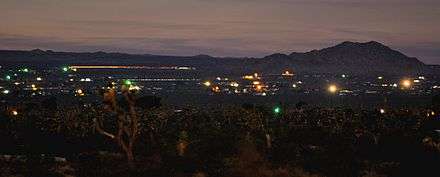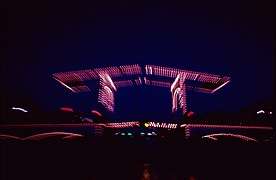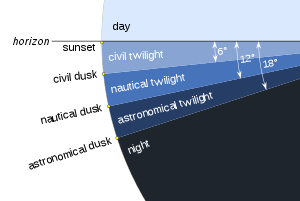Dusk
Dusk occurs at the darkest stage of twilight, or at the very end of astronomical twilight after sunset and just before night.[1] Pre-dusk, during early to intermediate stages of twilight, there may be enough light in the sky under clear conditions to read outdoors without artificial illumination, but at the end of civil twilight, when Earth rotates to a point at which the center of the Sun is 6° below the local horizon, artificial illumination is required to read outside.[2] The term dusk usually refers to astronomical dusk, or the darkest part of twilight before night begins.

Technical definitions
The time of dusk is the moment at the very end of astronomical twilight, just before the minimum brightness of the night sky sets in, or may be thought of as the darkest part of evening twilight.[4] But technically, the three stages of dusk are as follows.
- At civil dusk, the center of the Sun's disc goes 6° below the horizon in the evening. It marks the end of civil twilight, which begins at sunset. At this time objects are still distinguishable and depending on weather conditions some stars and planets may start to become visible to the naked eye. The sky has many colors at this time, such as orange and red. Beyond this point artificial light may be needed to carry out outdoor activities, depending on atmospheric conditions and location.
- At nautical dusk, the Sun apparently moves to 12° below the horizon in the evening. It marks the end of nautical twilight, which begins at civil dusk. At this time, objects are less distinguishable, and stars and planets appear to brighten.
- At astronomical dusk, the Sun's position is 18° below the horizon in the evening. It marks the end of astronomical twilight, which begins at nautical dusk. After this time the Sun no longer illuminates the sky, and thus no longer interferes with astronomical observations.[2][5]
Gallery
 Seattle, Washington during Nautical twilight
Seattle, Washington during Nautical twilight Civil twilight in Porto Covo, west coast of Portugal
Civil twilight in Porto Covo, west coast of Portugal- Astronomical twilight as seen from a plane window
 Magere Brug Amsterdam - Astronomical twilight
Magere Brug Amsterdam - Astronomical twilight View from Ibirapuera Park, São Paulo, Brazil, at Civil twilight
View from Ibirapuera Park, São Paulo, Brazil, at Civil twilight- Trees silhouette dusk sky
 Civil twilight in Albi, France
Civil twilight in Albi, France Amoudi Bay, Santorini, at dusk.
Amoudi Bay, Santorini, at dusk.- Nautical twilight in Vancouver, British Columbia, Canada
References
- The Random House College Dictionary, "dusk".
- U.S. Naval Observatory. Rise, Set, and Twilight Definitions.
- Van Flandern, T.; K. Pulkkinen (1980). "Low precision formulae for planetary positions". Astrophysical Journal Supplement Series. 31 (3). Bibcode:1979ApJS...41..391V. doi:10.1086/190623.
- "Full definition of Dusk".
- "Dusk – Definition and Meaning". www.timeanddate.com.

